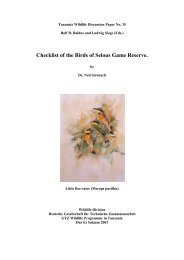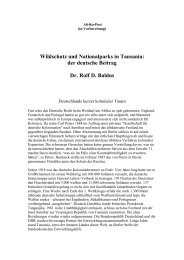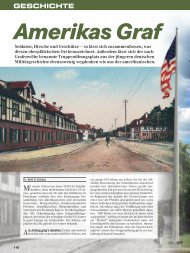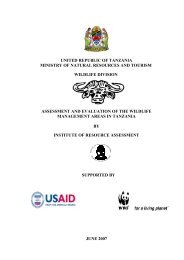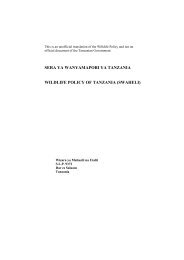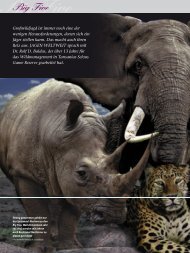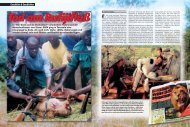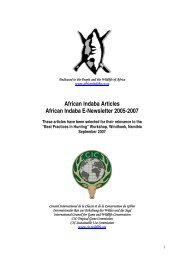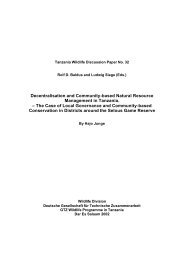Annotated History of the Selous Niassa Wildlife Corridor
Annotated History of the Selous Niassa Wildlife Corridor
Annotated History of the Selous Niassa Wildlife Corridor
You also want an ePaper? Increase the reach of your titles
YUMPU automatically turns print PDFs into web optimized ePapers that Google loves.
oundaries. The PDFA focuses exclusively on <strong>the</strong> sou<strong>the</strong>rn villages <strong>of</strong> <strong>the</strong> proposed corridor as itassumed that all <strong>the</strong> nor<strong>the</strong>rn villages will be supported through <strong>the</strong> SCP/GTZ programAugust 1999 A reconnaissance trip was made with Rudi Hahn (SCP), Dr. Drescher from <strong>the</strong>German Embassy, <strong>Selous</strong> sector wardens and antipoaching staff and village game scouts as wellas local guides. The objective was to collect first hand information about <strong>the</strong> proposed <strong>Selous</strong><strong>Niassa</strong> <strong>Wildlife</strong> <strong>Corridor</strong> including verification <strong>of</strong> wildlife populations, poaching status,information about human activities and settlements, wild fires and infrastructure. The 10 day tripwas conducted mostly on foot and covered approx. 150 kilometers from Ligunga southwardspast Matapwende, Ligusenguse, past <strong>the</strong> confluence <strong>of</strong> <strong>the</strong> Sasswara and Ruvuma rivers andonwards to Msangesi river. At this time <strong>the</strong>re were very few accurate maps for <strong>the</strong> region and <strong>the</strong>team used GIS coordinates to draw basic sketch maps. Based on <strong>the</strong> results from thisreconnaissance trip it was concluded that <strong>the</strong>re was sufficient intact habitat and low densities <strong>of</strong>human settlement to consider expanding <strong>the</strong> SCP project model to create a wildlife corridor from<strong>the</strong> <strong>Selous</strong> to <strong>the</strong> <strong>Niassa</strong> Game Reserve in Mozambique. Efforts also made in 1999 to establishcontact with <strong>the</strong> Mozambican <strong>of</strong>ficials and with <strong>the</strong> <strong>Niassa</strong> management in order to start buildingcross border cooperation.March 2000 The SCP project initiates discussion with district <strong>of</strong>ficials from Tunduru andSongea Districts and <strong>the</strong> Ruvuma region to explain <strong>the</strong> WMA concept and <strong>the</strong> proposed<strong>Corridor</strong>.May 2000 A PDFA grant is awarded by UNDP in support <strong>of</strong> <strong>the</strong> proposed <strong>Corridor</strong> for $13,500over two years (<strong>the</strong> original application was for $15,000). An expected output <strong>of</strong> <strong>the</strong> grant is anapplication for a medium sized project grant from <strong>the</strong> UNDP/GEF.May and October 2000 Wet and Dry Season Aerial <strong>Wildlife</strong> censuses conductedJuly 2000 Official research program begins to document <strong>the</strong> “Distribution and Movements <strong>of</strong>Elephants and o<strong>the</strong>r <strong>Wildlife</strong> in <strong>the</strong> <strong>Selous</strong>-<strong>Niassa</strong> <strong>Wildlife</strong> <strong>Corridor</strong> is launched. The teamincludes Heribert H<strong>of</strong>er, Thomas B Hildebrandt, Frank Göritz, Robert hermes, Donald G.Mpanduji, Rudi Hahn, Ludwig Siege, and Rolf D Baldus. Financial assistance is provided byTOEB <strong>of</strong> GTZ, <strong>the</strong> Institute for Zoo and <strong>Wildlife</strong> Research Berlin, <strong>the</strong> Messerli Foundation,Switzerland, and SCP. On <strong>the</strong> ground and personnel support also provided by Songea andTunduru Districts. The study was conducted between July 2000 and December 2002. Tenelephants were collared and <strong>the</strong>ir movements tracked and recorded using GPS, and <strong>the</strong>ir healthand reproductive status assessed. In October 2002 <strong>the</strong> radio-collars were removed from <strong>the</strong> studyanimals. Additional on <strong>the</strong> ground fieldwork was conducted with <strong>the</strong> assistance <strong>of</strong> local villagers,village game scouts and traditional hunters to gain additional information about wildlifepopulations, migration patterns, poaching and human-wildlife conflict.2000 Mtelawamwahi and Songambele (previously known as Mchomoro 2) are added to <strong>the</strong> SCPproject (Songea District). In addition, Darajambili, Namwinyu, Ndenyende, and Namakungwaare added to <strong>the</strong> SCP program in Tunduru District. Two teams are established to run <strong>the</strong> SCPprogram at <strong>the</strong> village level. The Tunduru DGO (Koishwa) accompanied by a District5



